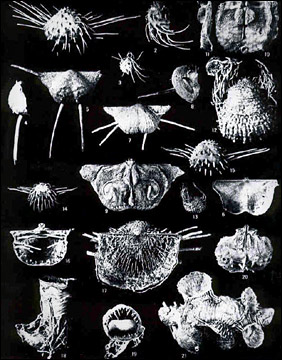
home
| Faunal Effects: Brachiopods v. Bivalves |
One of the longest held beliefs concerning the Permian extinction and the end of Paleozoic fauna concerns the reversal of dominance between bivalves and articulate brachiopods. It was originally thought that the superiority of the bivalves, in a competitive context, led to their dominance and the relegation of brachiopods to marginal environments. (Steele, 1979) This thinking was challenged by Gould and Calloway who, in 1980, showed the positive correlation in diversity between the two groups. A positive correlation indicates that brachiopod and bivalves are not directly competitive; furthermore, what is good or harmful for one group affects the other similarly. Thus, the diversity between the two groups in the Mesozoic must be related to different processes entirely. (Gould, 1980) Examination of distribution of marine communities in Paleozoic marine communities along two-dimensional onshore-offshore gradients suggests that the development of new near-shore communities progressively displace those already established in the area. One could assume that this is true for bivalves and brachiopods during the Triassic recovery period. (Sepkoski, 1987, 1989) The progressive displacement of Paleozoic brachiopod-plentiful communities by near-shore mollusk-plentiful communities seems apparent (Sepkoski, 1985). However, the actual data is consistent with a change in community structure occurring after the end-Devonian extinction event and remaining unchanged until the end-Permian. While the probability of extinction decreases exponentially with time (due, for example, to the decrease in overlap among adaptive zones), the probability of extinction within the biota was reset by the Permian end-extinction. (Van Valen, 1984) A decline in brachiopods was inevitable, but the decline was obscured by the end-Permian event. |

Figure: 21 Late Permian brachiopods from the Glass Mountains, Texas (Photo courtesy the Smithsonian Institute)